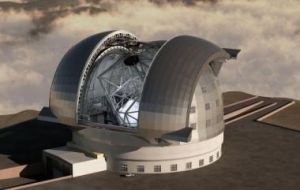MercoPress. South Atlantic News Agency
North of Chile, land of telescopes, preparing to promote “astronomy tourism”
 The world’s largest telescope in a hill close to Antofagasta
The world’s largest telescope in a hill close to Antofagasta With the installation of the world's biggest telescope planned in northern Chile many communities there are hoping the tourism industry will benefit from the world of astronomy.
The world's biggest telescope, the European Extremely Large Telescope, is to be built on Cerro Armazones, a mountain about 80 miles southeast of the city of Antofagasta. The largest radio astronomy project will also be constructed about 280 miles to the northeast, in Chajnantor, between 2012 and 2013.
Antofagasta plans to take cues from other communities in the region. With 2 million USD in investments, it plans to build a planetarium and meteorite museum for tourists. In many towns in northern Chile, money generated from planetariums has made astronomy tourism the second-most profitable businesses after mining.
Also, because the telescope will attract both scientists and tourists, the community anticipates increased demand for lodging, restaurants and other services. Restaurants have already begun capitalizing on the trend by naming dishes after starry themes such as “Milky Way”, “Big Bang” or “Magellan Cloud.”
Communities such as Paranal offer tour trips that allow visitors to observe constellations in the desert at night. It has also been possible for these communities to capitalize on astronomical events such as eclipses, comets and meteor showers.
Recently international tour companies made and planned trips to Chile for these types of events. TravelQuest organized an excursion to Easter Island, while MWT Associates is planning to visit the Atacama Desert in August to use the advanced telescopes of the region to view space from the clear skies of northern Chile.
Sernatur, Chile’s tourism promotion office has successfully joined forces with the European Southern Observatory that runs the Antofagasta complex to make it more visitors friendly. The site is open to public two weekends a month, and a visitor centre is under design. The town also plans to add more tour routes to help boost the industry.
“There have been approaches with ALMA,” Gustavo Herrera, the regional director of Sernatur, told El Mercurio “The idea is to operate all year with services that do not affect the work of scientists.”
By Kayla Ruble – Santiago Times




Top Comments
Disclaimer & comment rules-

Read all commentsStrategic decision to attract tourism. Without doubt Chile knows the way. It's good to see were the money goes. Here we're still waiting to see what happen with the so called “Bullet Train” among other project pompously announced.
Aug 04th, 2010 - 04:30 pm 0Commenting for this story is now closed.
If you have a Facebook account, become a fan and comment on our Facebook Page!